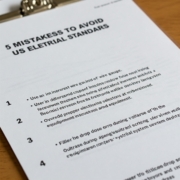Top 5 Mistakes to Avoid When Working with U.S. Electrical Standards
Top 5 Mistakes to Avoid When Working with U.S. Electrical Standards
Electrical systems are the backbone of any building, whether residential, commercial, or industrial. When designing, installing, or maintaining electrical systems, compliance with U.S. electrical standards is not just a best practice—it’s the law. However, even seasoned professionals can make mistakes that lead to non-compliance, safety hazards, or project delays.
In this blog post, we’ll cover the top five mistakes to avoid when working with U.S. electrical standards and how to ensure your electrical systems meet all the necessary regulations.
1. Neglecting Local Code Amendments
While the National Electrical Code (NEC) provides the foundation for electrical safety across the United States, it’s crucial to remember that local jurisdictions may adopt additional amendments or variations. These modifications often reflect regional concerns like climate, seismic activity, or specific energy efficiency goals.
For example, California has its own California Electrical Code (CEC), which incorporates not only the NEC but also local environmental and safety requirements. Some areas may also have specific codes regarding solar installations, electric vehicle charging stations, or earthquake-resistant electrical systems.
Solution:
Always verify with local authorities and check if your region has adopted any amendments to the NEC before proceeding with your designs or installations. This helps prevent costly rework and ensures compliance from the start.
2. Ignoring Load Calculations
One of the most critical aspects of electrical design is ensuring that the load calculations are accurate. Incorrect load calculations can lead to circuit overloads, fires, and equipment damage. Designers and engineers sometimes assume that the standard load factors will suffice, but every project is unique, and variations in room usage, building layout, and electrical demand should always be considered.
Common Pitfalls:
- Failing to account for future electrical loads (such as new appliances or office equipment).
- Incorrectly calculating voltage drops over long cable runs, which can lead to inefficient or dangerous systems.
Solution:
Carefully calculate the total load for each circuit and always factor in extra capacity for future changes. Use reliable software tools and ensure you follow the latest NEC guidelines on load calculations (e.g., NEC Article 220) to avoid under- or over-sizing circuits.
3. Improper Grounding and Bonding
Grounding and bonding are essential for the safety of electrical systems, as they prevent electric shocks and ensure that circuits trip when faults occur. Yet, one of the most common mistakes in electrical installations is improper or inadequate grounding.
Common Errors:
- Using incorrect grounding conductors or sizes.
- Failing to properly bond metal conduit or electrical equipment to the ground system.
- Neglecting to check grounding in older systems during upgrades.
Solution:
Always follow the NEC grounding and bonding requirements outlined in Article 250. Ensure that all metal parts of the electrical system are correctly bonded and connected to the grounding electrode system. Additionally, inspect older systems during renovations to ensure they comply with the current code.
4. Not Accounting for Energy Efficiency Requirements
With growing concerns about sustainability and energy consumption, energy efficiency has become a significant part of modern electrical standards. In some states, such as California, energy efficiency codes are strictly enforced under Title 24 of the California Building Standards Code.
Neglecting energy-efficient practices not only risks code violations but also increases operating costs for building owners. This could include using outdated lighting systems, inefficient HVAC systems, or failing to incorporate LED lighting and energy-efficient equipment.
Solution:
Make sure you are familiar with the energy efficiency codes applicable in your region, such as Title 24 in California or Energy Star guidelines. Incorporate energy-saving technologies like LED lighting, smart thermostats, and energy-efficient appliances to meet these codes. Also, conduct thorough energy audits during the design phase to ensure maximum efficiency.
5. Using Non-UL Listed Products
One of the easiest ways to avoid safety issues and legal headaches is by using UL-listed products. The Underwriters Laboratories (UL) is a nonprofit organization that tests and certifies electrical equipment to ensure that it meets stringent safety standards. Using non-UL listed products or attempting to use counterfeit electrical components can result in dangerous situations and non-compliance with the NEC.
Common Mistakes:
- Installing non-UL listed wiring or outlets that may not have been tested for safety.
- Using counterfeit electrical equipment that doesn’t meet regulatory standards.
- Overlooking UL certification during product selection.
Solution:
Always ensure that all electrical products, including wires, outlets, breakers, and panels, are UL listed. For equipment manufacturers or suppliers, request documentation and certifications that prove their products meet safety standards. This not only helps comply with codes but ensures long-term reliability and safety.
Bonus Mistake: Skipping Inspections and Permits
Even after all the hard work of following electrical standards, skipping proper inspections and permits can lead to delays, fines, and safety risks. Many projects fail to pass inspection because certain aspects of the system were not reviewed by a licensed inspector before the final installation.
Solution:
Ensure that all electrical installations are thoroughly inspected by a licensed professional before finalizing the project. Always obtain the necessary permits before beginning work, and ensure that the inspection is conducted at each critical phase of the electrical installation.



